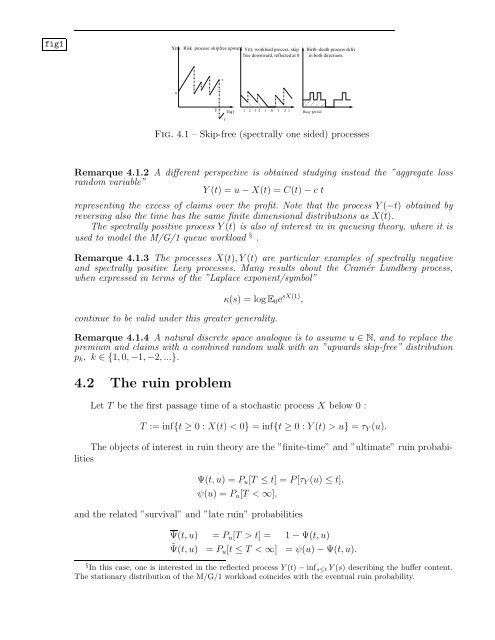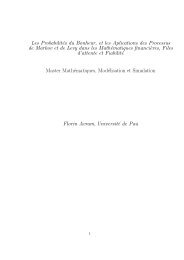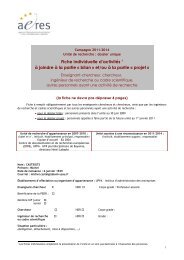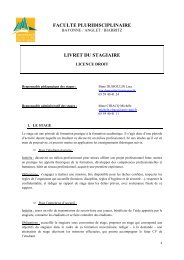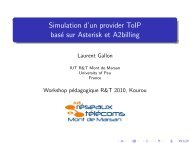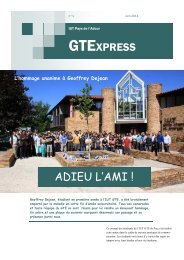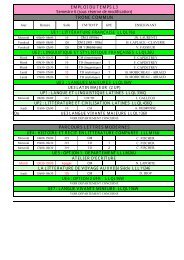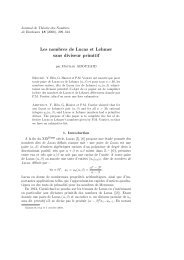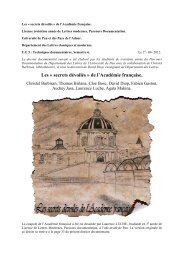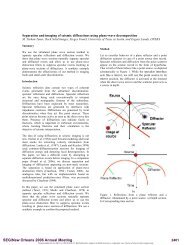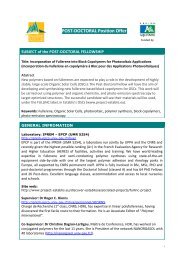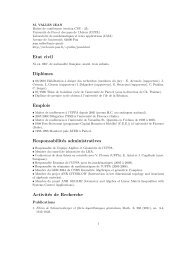Processus de Markov, de Levy, Files d'attente, Actuariat et Fiabilité ...
Processus de Markov, de Levy, Files d'attente, Actuariat et Fiabilité ...
Processus de Markov, de Levy, Files d'attente, Actuariat et Fiabilité ...
You also want an ePaper? Increase the reach of your titles
YUMPU automatically turns print PDFs into web optimized ePapers that Google loves.
fig1<br />
X(t): Risk process: skipfree upward Y(t): workload process, skip<br />
free downward, reflected at 0<br />
Birth−<strong>de</strong>ath process:skfree<br />
in both directions.<br />
x<br />
u<br />
T<br />
−y<br />
τ(q)<br />
1 2 1 2 1 0 1 2 1 Busy period<br />
Fig. 4.1 – Skip-free (spectrally one si<strong>de</strong>d) processes<br />
Remarque 4.1.2 A different perspective is obtained studying instead the ”aggregate loss<br />
random variable”<br />
Y (t) = u − X(t) = C(t) − c t<br />
representing the excess of claims over the profit. Note that the process Y (−t) obtained by<br />
reversing also the time has the same finite dimensional distributions as X(t).<br />
The spectrally positive process Y (t) is also of interest in in queueing theory, where it is<br />
used to mo<strong>de</strong>l the M/G/1 queue workload § .<br />
Remarque 4.1.3 The processes X(t), Y (t) are particular examples of spectrally negative<br />
and spectrally positive <strong>Levy</strong> processes. Many results about the Cramér Lundberg process,<br />
when expressed in terms of the ”Laplace exponent/symbol”<br />
κ(s) = log E 0 e sX(1) ,<br />
continue to be valid un<strong>de</strong>r this greater generality.<br />
Remarque 4.1.4 A natural discr<strong>et</strong>e space analogue is to assume u ∈ N, and to replace the<br />
premium and claims with a combined random walk with an ”upwards skip-free” distribution<br />
p k , k ∈ {1, 0, −1, −2, ...}.<br />
4.2 The ruin problem<br />
L<strong>et</strong> T be the first passage time of a stochastic process X below 0 :<br />
T := inf{t ≥ 0 : X(t) < 0} = inf{t ≥ 0 : Y (t) > u} = τ Y (u).<br />
The objects of interest in ruin theory are the ”finite-time” and ”ultimate” ruin probabilities<br />
Ψ(t, u) = P u [T ≤ t] = P[τ Y (u) ≤ t],<br />
ψ(u) = P u [T < ∞],<br />
and the related ”survival” and ”late ruin” probabilities<br />
Ψ(t, u) = P u [T > t] = 1 − Ψ(t, u)<br />
˜Ψ(t, u) = P u [t ≤ T < ∞] = ψ(u) − Ψ(t, u).<br />
§ In this case, one is interested in the reflected process Y (t) − inf s≤t Y (s) <strong>de</strong>scribing the buffer content.<br />
The stationary distribution of the M/G/1 workload coinci<strong>de</strong>s with the eventual ruin probability.


